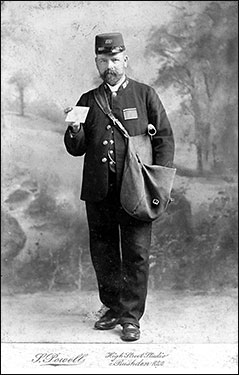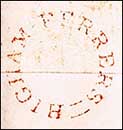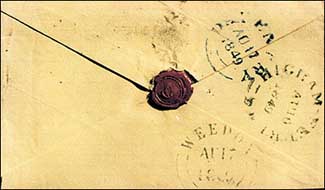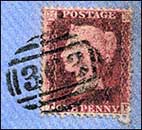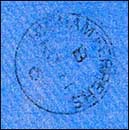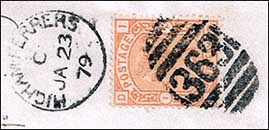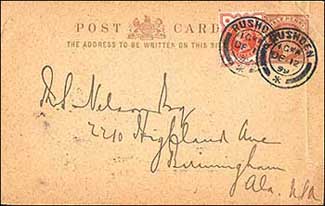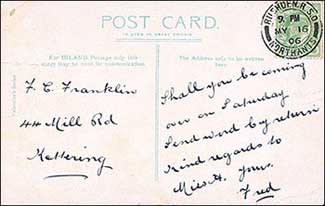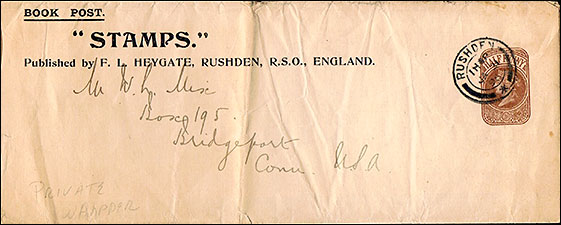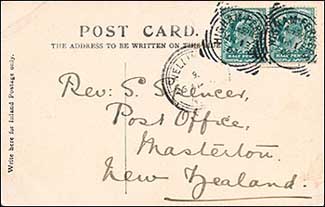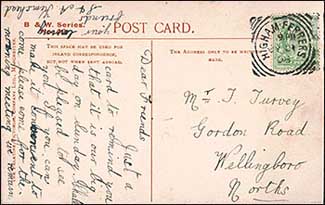|
|
|||||||||||||||||||||||||||||
| Article and images by Richard Colson, 2020 |
|||||||||||||||||||||||||||||
|
The Local Postal Service until 1921 |
|||||||||||||||||||||||||||||
|
|
|||||||||||||||||||||||||||||
The Postal Service began as a national service in the time of Henry VIII and Elizabeth I, but inland mail was reserved to royalty and parliament; mainly because the king and queen suspected treason and liked to keep their subjects isolated to avoid plots against themselves. Even when the post office became open to everyone there were no Post Offices. Letters were handled through a room in a local inn such as the Green Dragon in Higham Ferrers … usually the Inn that provided horses for the postal service to ride ‘to post’ meaning that the rider rode some miles, then swapped horses to ride the next stage in their journey. The name Post Office comes from the idea of riding ‘to post.’ The earlier letters had no addresses as such, usually saying something like ‘Two doors from the sign of The Angel’ meaning two doors away from the pub called the Angel. There were no letter boxes, and the letters were not prepaid. The person receiving the letter had to pay the postage! |
|||||||||||||||||||||||||||||
|
Image 1 shows a letter from 1743. The spelling of Higham Ferrers was not standardised for some years and this letter shows HIGHAM FERRIS in two lines and a Bishop Mark for 5th January. |
|||||||||||||||||||||||||||||
By the late 1830s the straight line cancellers had gone. The new cancellers for Head Offices were round (Image 5) and after 1840 Post Offices gradually moved over to new metal stamps that had metal date slugs in the middle that could be changed to show the date the letter was sent.
The other change was that Post Towns like Higham Ferrers were given barred oval cancellers containing a number. (Image 6). Higham Ferrers was issued with 363. (Image 7). By 1861 the date canceller had become smaller and there was now a time letter above the date. Some offices changed these very regularly throughout the day A at 6am and G at 8pm for instance. It depended upon the number of collections each day. (Image 8).
It may be noted that Post Offices were often open 5am to 10pm six days a week and often on part of Sunday as well. There was one delivery on Christmas Day! It should be remembered that we are still at a time where universal education had not started and most people never got letters and probably could not read. Where people got letters, many had servants who would collect the post from the post office for their employer. Although I have not seen this for the Rushden area one can read lots of letters to the Press of the time about irate residents saying how undignified it was for houses to have house numbers, and worst of all, having to cut a slot in their beautiful front door for delivery of the mail! It is probably true that the small number of houses in Higham and Rushden that received mail probably meant that everyone knew who they were without a proper address! During all these years Rushden didn’t have a Post Office. The first sub-office opened in 1851 but it didn’t last long and closed in 1863, only to be re-established in September 1871 in High Street South. The letters still received a Higham Ferrers cancellation but Rushden, like other sub-offices had an undated canceller that was used on the back of each envelope to show its origin.
In 1845 Higham Ferrers got its first railway station on the L&NWR that passed through Wellingborough London Road station on its way to Peterborough. It was variously called Higham Ferrers, Irthlingborough for Higham Ferrers; and lastly Irthlingborough. The most significant Inn in the town, The Green Dragon was the parcels receiving office for the L&NWR. In 1895 a new railway station was opened at the end of a short 5 mile long branch line run by the Midland Railway from Wellingborough Midland Road station. Trains stopped at Rushden and at Higham Ferrers, the terminus. The Queens Head pub was the parcels receiving office for the Midland Railway. It is strange how the railways and the postal service developed in tandem during the nineteenth century but postal historians, transport historians and and railway postal historians have rarely seemed to cross paths until recently. Nowadays, Postal historians and Railway philatelists have come to enjoy each other’s hobby more, but the transport historians seem to give very little consideration to the carriage of the mail. Two books have been published in recent years on the history of the Higham Ferrers and Rushden railway branch line; but apart from mentioning that Rushden had a parcels office, there is nothing reported; but every railway station offered an express letter service where a railway letter stamp was used as well as the post office postage stamp. The letter went most of the way by train then it was posted for local delivery by the Post Office. This arrangement did not breach the Post Office monopoly. There is a huge range of railway letter stamps both before unification of the railways and also once British Railways was created. Combined with the equally large range of parcel stamps and newspaper delivery stamps one has an almost inexhaustible area for collecting and study. Whilst railway stamps are quite common, stamps cancelled at Rushden or Higham Ferrers stations are not. Like so many of these stamps, they were stuck to a newspaper wrapper or parcel and thrown away after delivery. If one could find an example from either station then an £80-100 price tag would be likely. By the end of the nineteenth century the small Head Office in Higham Ferrers was not fit for purpose, and Rushden was growing at a much faster rate; so a new Head Office was needed and Rushden was chosen. Unfortunately there was no suitable building of substance in the town and it is believed that the Rushden Railway Sub-Office (R.S.O.) stepped up to the plate to support the postal service until the new Head Office in the town had been completed. Postcards and letters cancelled with Rushden RSO are very common for this period and seem to be far fewer items with a simple Rushden cancellation.
This wrapper for the “Stamps” magazine shows the address for the Railway Sub-office, but the postmark of the normal office. Such is the nature and the fun of postal history.
The double arc RUSHDEN hand stamp is believed to have been used for the High Street sub-post office. The existing sub-office remained in use until the new High Street office was well established, but was renamed High Street South. It only remained open until 1916. The Higham Ferrers RSO handstamp (if it existed) is much more elusive. The Higham RSO is known to have opened on the same day as the Rushden RSO, 1st September 1892, and the Kelly’s Directory for 1898 asks that mail to be sent through the RSO, but Higham Ferrers was still using its Squared Circle canceller like two images below dated 1904 and 1908, so it is believed that the Railway sub-office was the previous Head Office in Wood Street just renamed.
The new Rushden Post Office was built in 1902, and opened in April 1903. Rushden became the new Head Office on 1st August 1905, albeit temporarily, and on the same day Higham Ferrers RSO was renamed as a sub-office. The next year all Railway Sub-offices countrywide were renamed as just ‘sub-offices’ whether they were at a station or not. Many sub-offices that had previously been RSOs took their handstamps that had R.S.O. on them and used a file to wear off the R except for the bar across the middle leaving -.S.O. . Rushden did not do this and Higham had kept its old canceller it would seem. The village sub-offices that received their mail from the Higham Ferrers Head Office in the early days had been whittled away. As examples, Finedon had moved to Wellingborough in 1867, Irthlingborough and Stanwick moved to Wellingborough in 1903, and Riseley had moved to Bedford in 1871.
|
|||||||||||||||||||||||||||||
